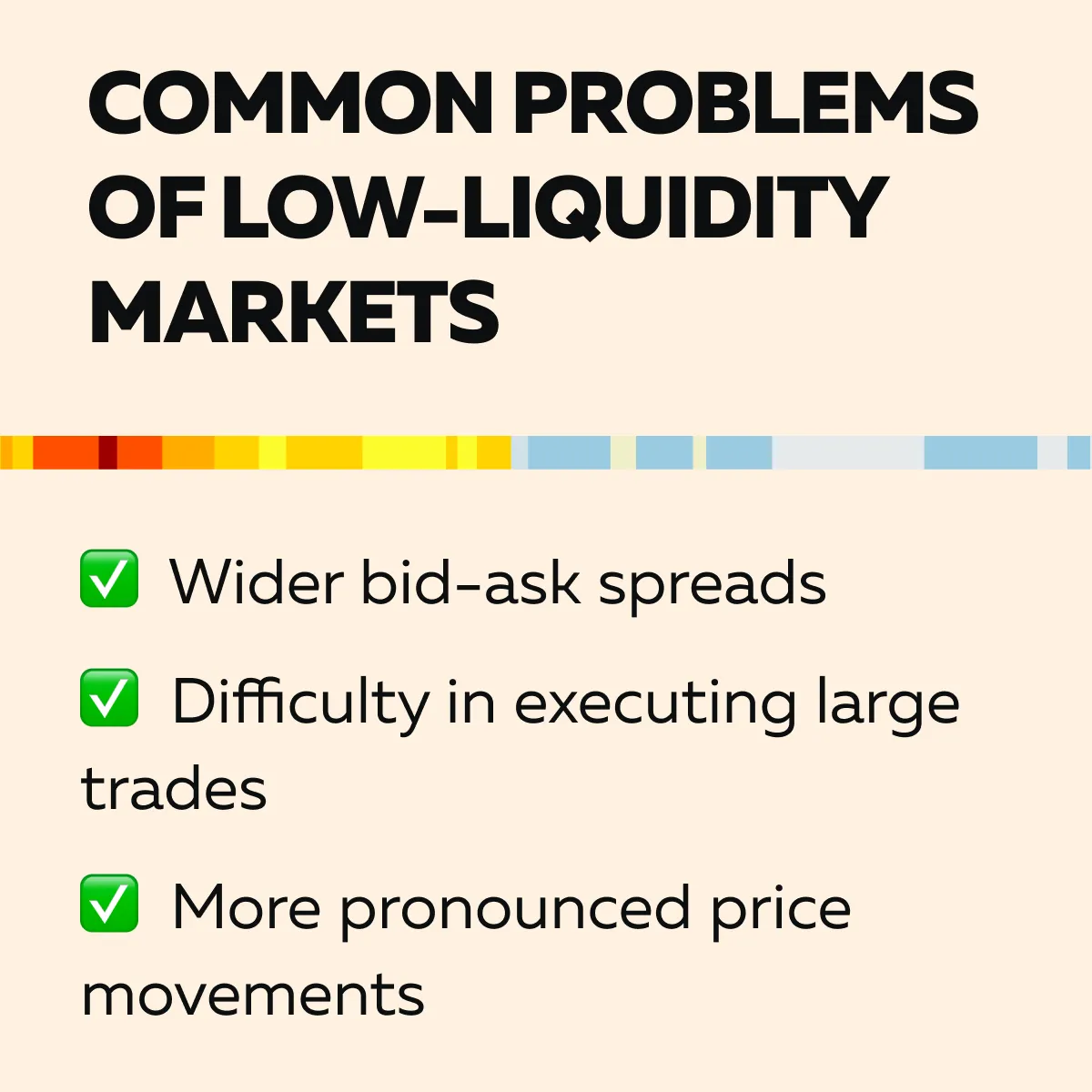Ready to see the market clearly?
Sign up now and make smarter trades today
Education
December 27, 2024
SHARE
Trading Strategies Leveraging Liquidity: Boost Your Market Edge
Some traders thrive in volatile and erratic markets, while others make money in smooth and steady environments. Ever wondered why? Well, it all comes down to liquidity.
In this article, we’ll break down the concept of liquidity and the vital role it plays in different trading strategies. You’ll learn what liquidity is and how it affects the ease with which one can buy and sell financial assets. We’ll cover the three main types of liquidity: market, asset, and funding liquidity. Also, you will see why large institutional investors prefer high-liquidity markets while savvy retail traders often seek out opportunities in low-liquidity spaces.
Next, we’ll explore specific strategies for both high and low-liquidity markets. You’ll see how scalping works best in highly liquid markets like major stock indices, while arbitrage traders need liquidity to move efficiently between different exchanges. On the flip side, we will also cover breakout trading and trend-following strategies, which are highly preferred in low-liquidity markets. Let’s begin.
What is Liquidity in Trading?
Liquidity can be defined as the ease of purchasing or selling an asset in a market without impacting its overall price. In other words, it is the ease of converting an asset into cash or another asset with minimal loss in value. When it comes to trading, liquidity is a key concept as it affects how easily traders can enter or exit positions. Generally, there are two types of liquidity positions:
| Aspects | High liquidity | Low liquidity |
| Features |
|
|
| Example |
|
|
Trade with confidence. Reduce your risk by tracking liquidity levels. Use our platform’s modern tools today!
Types of Liquidity
Please note that liquidity is a multifaceted concept. Both traders and investors must understand its various manifestations. That’s because each type of liquidity influences how
- assets are traded,
- price moves, and
- participants manage risk.
In order to better understand the concept let us now study the three major types of liquidity.
Type I: Market Liquidity
It refers to the ease with which an asset can be traded in a particular market without causing significant price changes. This depends on the availability of buy and sell orders in the market’s order book. When the order book is deep (i.e., there are numerous buy and sell orders at different price levels), liquidity is high. Due to this high market liquidity, large orders exchange hands without affecting the market price significantly. In contrast, low market liquidity means that executing large trades can cause significant price changes. This is known as “price slippage”.
For example:
Large institutional investors, such as organizations that run pension funds or hedge funds, prefer high-liquidity markets (like blue-chip stocks or major forex pairs). This preference allows them to trade large volumes with minimal impact on prices, avoiding slippage.
Type II: Asset Liquidity
It refers to how swiftly an asset can be sold for cash without significantly losing value. Highly liquid assets can be sold quickly at close to their market value. For example, U.S. Treasury bonds are considered very liquid because they can be easily sold in the market. On the other hand, illiquid assets, such as real estate or rare collectibles, usually take more time to sell and might even require price concessions to find a buyer.
For example:
Stocks in major indices like the S&P 500 are highly liquid assets. On the other hand, rare art or shares in small-cap companies are much harder to sell at a fair price.
Type III: Funding Liquidity
This refers to the ability of traders or financial institutions to meet their short-term obligations, such as:
- Margin calls,
- Loan repayments, and
- Other financial commitments.
One must note that funding liquidity becomes highly important during times of financial crises or market stress when liquidity dries up. During these periods, traders and institutions struggle to obtain loans or sell off their assets to meet their obligations.
For example:
In the 2008 financial crisis, many financial institutions faced a funding liquidity crunch when their access to short-term financing collapsed. As a result, they were forced to sell assets at discounted prices. Some even tried to get emergency funding to stay solvent.
Institutional vs. Retail Usage of Liquidity

It is worth mentioning that different market participants use liquidity as per their strategies and preferences. Large institutional investors, like mutual funds or pension funds, prefer high-liquidity markets as they minimize their slippage. In such high-liquidity markets, institutions can execute large orders without significantly impacting prices. This helps in maintaining their strategy and returns.
Retail traders, on the other hand, benefit from identifying liquidity gaps. For the unaware, these gaps represent moments when liquidity is low. It leads to arbitrage opportunities. Furthermore, liquidity gaps occur when there is a temporary mismatch between buy and sell orders. Usually, this results in price inefficiencies. Traders can exploit these inefficiencies for profit by purchasing assets at cheaper prices and selling them when liquidity improves.
Strategies for Trading in High-Liquidity Markets

In high-liquidity markets, assets are easily traded. There are no significant price movements or any major impact on the asset value. Such a situation makes it ideal for certain trading strategies that rely on fast execution and low transaction costs. Now, let’s have a look at these trading strategies:
Strategy I: Scalping
Scalping is a popular trading strategy. Here, traders aim to profit from small price movements within short timeframes. These trades are often held for mere seconds or minutes. If we talk about the importance of liquidity, be aware that high liquidity is crucial for scalping. That’s because it ensures that traders can enter and exit positions quickly without experiencing significant price slippage.
In high-liquidity markets, scalpers can execute trades rapidly and at prices close to what they anticipated. In this way, they can avoid large price swings due to market orders.
Use our platform, Bookmap to gain a deeper understanding of market depth. Start making smarter trading decisions. Join now!
Strategy II: Bid-Ask Spread
Liquidity has quite an important part in reducing the bid-ask spread. For the unaware, it is the difference between the buying (bid) price and the selling (ask) price. In highly liquid markets, the bid-ask spread is narrower. This implies that the cost of executing a trade is lower. This allows scalpers to profit from even the smallest price changes. Besides, there are no high transaction costs that eat into their profits.
For example,
- Say the spread on an S&P 500 futures contract is just a few cents.
- Now, a scalper quickly buys and sells within this range.
- By doing so, they capture small profits multiple times a day.
Another key benefit of high-liquidity markets is that due to the large volume of buy and sell orders, individual trades have minimal impact on the overall price. This allows scalpers to enter repeatedly and exit trades without affecting the market price. One must acknowledge the fact that such repeat entries and exits are important to capture small price movements consistently.
For example:
Say a scalper is trading S&P 500 futures or highly liquid stocks like Apple. Now, they achieve several benefits. Check the graphic below:
| Narrow spreads | Deep order books | Fast execution |
| The gap between the buy and sell price is minimal. This reduces the cost of trading. | A large number of buy and sell orders are available at various price levels. This allows the scalper to enter quickly and exit trades. | High liquidity ensures that the trader’s orders are filled almost instantly. This allows them to capture small profits in seconds or minutes. |
Strategy III: Arbitrage Trading
Arbitrage refers to making the most of price discrepancies between two or more markets or instruments. The goal is to purchase an asset in a cheaper market for a low price and then sell it for a profit at a more expensive rate in another market.
How Important is High Liquidity?
High liquidity is important for arbitrage trading as traders require liquidity to execute orders quickly in both markets. Liquidity ensures that they can buy and sell large amounts without significantly impacting the price in either market.
The price differentials in arbitrage trading are often very small. So, even minor slippage (price changes between placing and executing trades) can wipe out profits. High liquidity minimizes this risk and allows for precise and efficient execution.
What is Cross-Exchange Arbitrage?
It is a common form of arbitrage. In this type, traders exploit price differences for the same asset on different exchanges. Here, high liquidity on both exchanges ensures that traders can enter and exit positions simultaneously. This reduces the risk of the price moving before the arbitrage opportunity is captured. For example:
- Say a trader notices a price discrepancy between a futures contract on one exchange and the price of the underlying asset on another exchange.
- They buy the asset for cheap in one market and sell it for a mark-up in another market.
- By doing so, they profit from the difference.
In this case, high liquidity in both markets ensures that the trades can be executed quickly and efficiently. This maximizes the arbitrage opportunity.
Strategy IV: Mean Reversion
Mean reversion strategies are centered on the idea that asset prices will gravitate back toward their historical average (or mean) after a deviation. Traders using this strategy look for prices that have moved far from their historical norm and anticipate that they will revert to that average over time.
How Important is High Liquidity?
Generally, high-liquidity markets have more consistent price movements and lower volatility. This makes it easier to spot when prices have deviated from their mean, as extreme price swings (often seen in low-liquidity markets) are less common.
Because high-liquidity markets are more stable, they provide clearer signals for mean reversion. This allows traders to make more confident predictions about when and how prices will revert.
Price Stability and Pattern Recognition
In high-liquidity markets, prices follow smoother patterns. This makes it easier for traders to recognize:
- When prices deviate from their mean?
and
- When are they likely to revert?
Here, high liquidity ensures that prices are less affected by large orders from individual participants. This makes mean reversion strategies more reliable. For example:
- A trader uses a mean reversion strategy in the EUR/USD futures market.
- For the unaware, this market is well-known for its high liquidity.
- Say the price of EUR/USD rises significantly above its 20-day moving average.
- Now, the trader shorts the position as they are expecting that the price will revert to its historical mean.
- High liquidity in the EUR/USD market reduces erratic price spikes.
- It allows the trader to make a more informed decision about when the price is likely to return to its average.
Ready to leverage liquidity in your trading strategy? Our heatmap tool can help you spot liquidity zones and time your trades more effectively. Start now!
Trading Strategies for Low-Liquidity Markets
Low-liquidity markets include assets like small-cap stocks, certain niche commodities, and some lesser-known cryptocurrencies. In these low-liquidity markets, price action is more erratic and volatile. This happens due to fewer buy or sell orders, which makes price swings larger and more unpredictable. Check the graphic below to understand some common problems of low-liquidity markets:
Now, to make profits even in such a trading environment, you can follow these two key strategies:
| Aspects | Breakout Trading | Trend following |
| What Does it Mean? |
|
|
| Why does it work in Low-Liquidity Markets? |
|
|
| Example |
|
|
Key Points to Consider for Low-Liquidity Markets
- Low liquidity usually means wider bid-ask spreads. This increases transaction costs.
- Traders should manage transaction costs by adjusting their entry/exit points accordingly.
- Due to fewer orders in the market, price swings are larger and more sudden.
- In low-liquidity markets, executing large trades can move the market.
- Traders must remain cautious with position sizing.
Conclusion
When it comes to trading, liquidity is a key factor that generally exists in two forms: high and low. High-liquidity environments are more closely related to large-cap stocks and major index futures. In this setup, trades can be executed quickly and efficiently with minimal price slippage. Strategies like scalping benefit from these conditions. That’s because narrow bid-ask spreads and deep order books allow traders to enter and exit positions rapidly while capturing small profits on frequent trades. Moreover, liquidity ensures that prices remain stable. It is highly important for strategies that rely on fast execution and reliable price action.
In comparison, low-liquidity markets (related to small-cap stocks or niche cryptocurrencies) offer different opportunities. Here, breakout trading and trend-following strategies are more suitable as these can capitalize on the more volatile price swings caused by fewer buy and sell orders. While low liquidity increases volatility and makes trade execution more challenging, it also enables significant price movements that lead to larger profits if timed correctly.
Ultimately, liquidity dictates how traders approach the market. In highly liquid markets, traders focus on efficiency and precision. Contrarily, in low-liquidity markets, they adapt to the greater volatility and try to benefit from extended price trends. Want to monitor liquidity in real time? Try our Liquidity Tracker for a clearer view of market depth.

